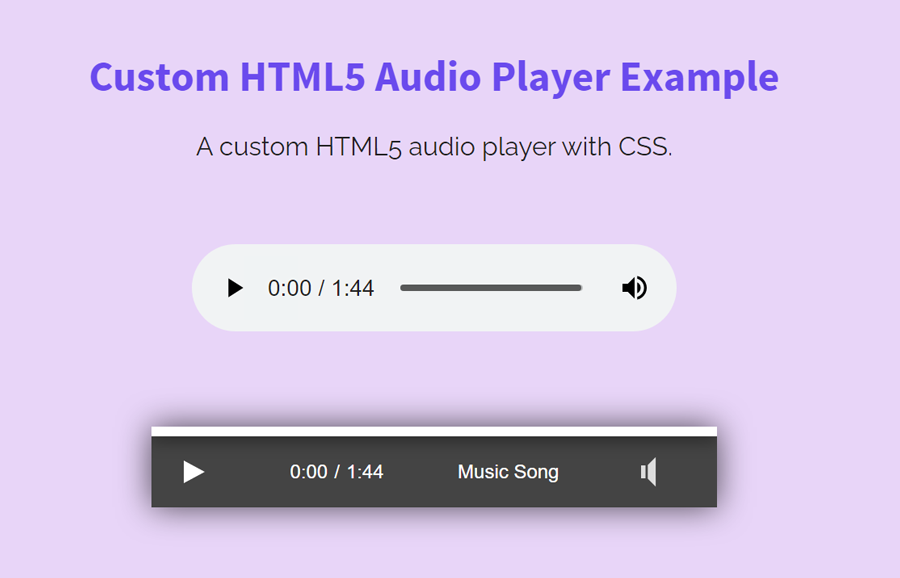

I am using web unicodes for the play/pause icons so I have to adjust the fontSize, but you can get the same effects using a font awesome font or SVGs. With this all we are doing is checking if the audio is paused and calling ay() it if is, otherwise we pause it.

Along with the ‘paused’ flag, we can make use of common tags such as ended. The Audio element has a number of boolean flags set on it so that we don’t have to be taxed with creating our own flags for object state. The pause and play methods in our playButton event listener. Here is what the body of our HTML file should look like at this point:įigure 5. Because we aren’t using the default audio UI by including ‘controls’, we will need to create our own UI. The final changes we will do with this HTML file are to add the container and structure elements for our audio player. We will set the src attribute of our audio tag to “/final_files/assets/indie_song.mp3” which will instantiate a new Audio object with our song. The mp3 file for our song is stored in the ‘assets’ directory. The current file should have a body containing only a blank tag. Change into the ‘starter_files’ directory and open the HTML file. To start, clone my project repository ( ). The second is to create an instance of the Audio object in JavaScript and then manipulating HTML tags from the script file.įor our solution we will add an tag to our index.html and then access it through our script.js file. The first is to create the audio object using the tag and accessing it in your JS file by hooking into its class or id. There are two main approaches to building a custom UI audio player with Vanilla JavaScript. Another solution (link in the notes) is to use React and tie into the player using React Hooks and yet another solution I have implemented involved using NextJS and Typescript to create a hydrated player (though you have to be careful because Web APIs are not available in Node). The beautiful thing about web development is there are so many different ways to create this audio player. For this tutorial I would like to use Vanilla JavaScript with HTML and CSS. We can change that by hooking into the our HTMLAudioElement instance.
#Html5 audio controls how to#
If you do care about how your UI looks, let’s look at how to create your custom audio player!Īs mentioned previously, the default audio UI offered by the tag is functional, but not always visually appealing. If you need something that works, but don’t care how it looks, an tag with the controls attribute will work great. Making this even more of an issue is that the display is not uniform across browsers and there is very little CSS that can target and alter the display characteristics of this player. While this is great for a quick and dirty MVP, the visuals of the default controls aren’t great. However, the audio tag has a popular attribute of ‘controls’ which will display a pause/play button, progress bar and volume controls:įigure 1. The default behavior of the audio tag is to not be visible on the screen. In order to avoid attaching a separate script to your page, HTML5 offers a new tag that accepts a source attribute for your audio file and returns a new instance of the HTMLAudioElement object. It also added a number of functional tags for bringing our pages to life. The release of HTML5 added a number of semantic tags to our arsenal that offer meaning to our web document’s structure. What should we do if we want to use this API in our webpages?
#Html5 audio controls update#
This information is great if you are looking to manipulate or update your pages based on the state of your audio file. This object constructor accepts an optional url to an audio file and returns a new HTMLAudioElement that can be used to check track duration, currentTime, volume, offers pause and play functions and checks for different states such as ended and paused. A popular API for websites offering music services is the Audio API. JavaScript offers a number of cross browser Web APIs to allow us to interact with high level coding concepts. Today we are going to look somewhat in depth into the Audio Web API, the HTML5 audio tag and finally how to use these two items to create our own visually customizable audio players. Thankfully the default for most browsers is to prevent this autoplay functionality, but audio and specifically music are still a huge part of today’s internet.

If you’ve been on the web since the mid 1990’s you probably remember the annoying songs and sounds that would blast through your speakers whenever you loaded a new page.


 0 kommentar(er)
0 kommentar(er)
